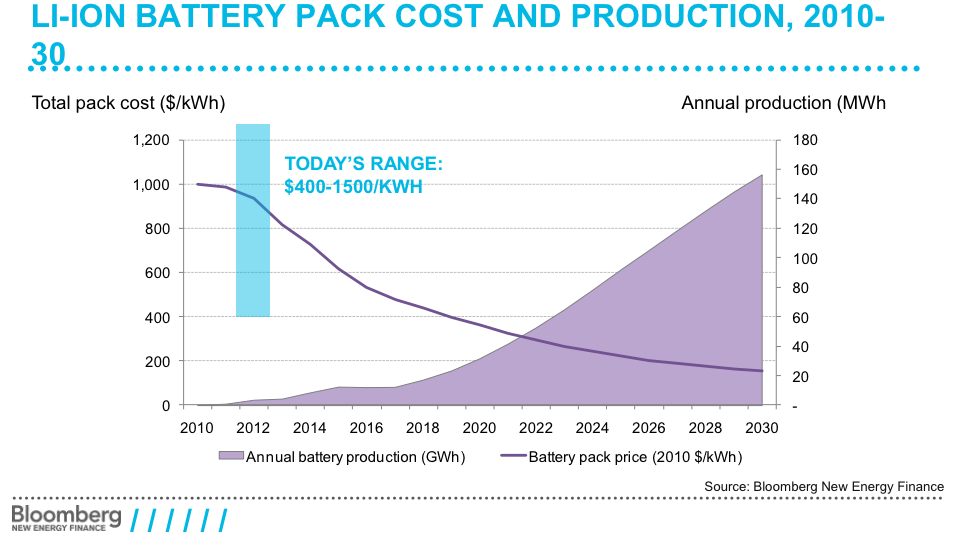While the cost of solar PV is no longer the roadblock to widespread adoption it used to be, one can’t say the same about its intermittent nature, which continues to be a source of criticism from renewable energy detractors.
However, as researchers develop ways to make battery tech cheaper and existing battery techs reaching larger economies of scale, this may change soon. Analysts are increasingly predicting cost reductions for battery tech as an energy storage solution for distributed power sources such as solar PV.
The drop in prices predicted is not unlike the system price reductions seen in the PV sector, where economies of scale have enabled widespread adoption of the technology. According to Dr. Dirk Sauer of Aachen University’s Electrochemical Energy Storage Systems group, economies of scale for both lithium ion and lead acid batteries are expected to cut battery costs by one-half to two-thirds.
Image Courtesy: Bloomberg New Energy Finance
“Four years ago it was predicted that the prices for battery cells, if you buy large quantities as car manufacturers do, would go below €200/kWh for cells by 2020. What you see today is that prices are well below this. Tesla is probably buying battery cells from Japanese manufacturers for US$150/kWh.”, said Sauer, referring to the lithium ion batteries used by Tesla Motors, the highly successful electric car manufacturer. Extending the analysis to lead acid batteries, Dr. Sauer states, “In home systems today, lead acid batteries are sold to the end user at €150 to €200/kWh, yet battery suppliers for car starter engines are sold to automotive manufacturers for €25/kWh.”
Automotive battery manufacturers routinely manufacture about 5 million starter batteries a year in total. Although these are not the deep-cycle type that are required for energy storage applications, the scale of operation suggests that it may be possible to provide about half a million 10kWh residential storage systems. This figure is about a quarter of the total number of renewable energy systems installed in Australia.
Such large-scale battery deployment could significantly change the electricity demand in the grid. Distributed energy storage, in particular, would be a good complement to distributed energy sources like PV by absorbing the power surges in low- and medium-voltage grids in which PV systems are typically installed. By carefully adjusting when and how much of the PV electricity is fed into the grid, it is possible to smooth out grid demand. Energy storage can also help improve the quality of grid power through frequency control and voltage stabilisation – reducing the need to build new sub-stations to regulate the grid.
However, simply connecting batteries to the grid will not automatically provide all these benefits. In fact, an unregulated proliferation of storage systems can actually destabilise the grid. This can occur, for example, when a number of small residential storage systems on the same sub-section of the grid all become full at the same time (as can occur following sunny days with low demand), which could cause unexpected surges in PV output that may overload the grid. Regulated battery control strategies are thus essential to enabling large-scale adoption of energy storage.
At the most recent International Renewable Energy Storage Conference and Exhibition (IRES) in Berlin, researchers from Munich’s Technical University and Stuttgart’s Centre for Solar Energy and Hydrogen Technologies (ZSW) presented such approaches where they dynamically controlled the time of day that batteries charge (from PV arrays) and discharge themselves (into the grid) based on the predicted weather, predicted household demand and the grid condition at the time. Such strategies benefit both the end user (by allowing the batteries to charge up to full capacity during the day but ensuring discharge in the evenings and nights) as well as the grid (by minimising the frequency and potency of power surges in low- and medium-voltage grids).
The data needed to implement such schemes is not hard to find or produce, and the technology required to implement it is well within our reach. However, what’s missing are the policy and market incentives to do it.
Germany, a pioneer in adopting distributed energy such as solar PV, is no stranger to such issues, but researchers there are hopeful that utilities and policy makers will see the benefits that grid storage brings to the grid and to homeowners. Sauer states, “The large utilities think a lot about decentralised storage systems because they understand that these systems most probably will come if they want them or not. Now they are looking very carefully at how they can be a part of the game and they are also thinking about if they can be one of the big suppliers of such systems. If they install them themselves, they can use them much easier for grid services.”
The situation is not too different in Australia. With a current installed PV capacity of 3GW and falling average and peak demand revealed in the National Electricity Market consumption data, the scale of benefit that distributed energy and energy storage have is obvious. Add to this the current reality of low feed-in-tariffs and predictions of falling battery prices, and the possibility that Australian energy consumers may tack on distributed energy storage to their PV systems becomes very real. Whether, when and how the utilities and regulators will react to this remains to be seen.
Top image by Solarpraxis/Andreas Schlegel, via PV Magazine.
© 2014 Solar Choice Pty Ltd
- Future of Utilities – Part 1: The death of base-load generators - 11 September, 2014
- Sharp enters energy storage market with SmartStorage - 18 August, 2014
- Phinergy extends electric car range with metal-air battery technology - 13 August, 2014
